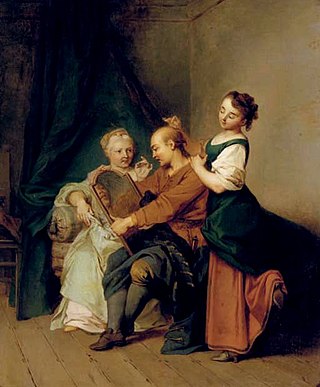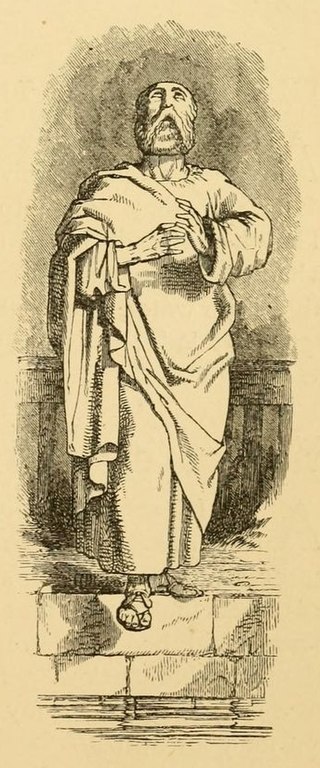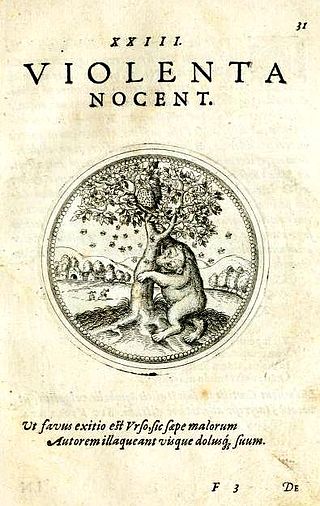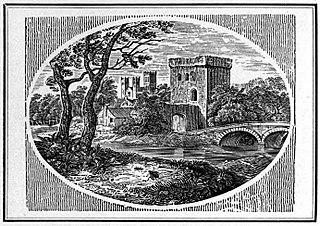
The Old Woman and the Wine Jar is one of Aesop's Fables and is numbered 493 in the Perry Index. It has been applied to situations where an influence for good is lasting, such as the effect of education.

The Old Woman and the Wine Jar is one of Aesop's Fables and is numbered 493 in the Perry Index. It has been applied to situations where an influence for good is lasting, such as the effect of education.
The story appears in the form of a short anecdote in the collection of Phaedrus and concerns an old woman who comes across an empty wine jar, the lingering smell of which she appreciatively sniffs and praises, saying 'Oh sweet spirits, I do declare, how excellent you must once have been to have left behind such fine remains!' [1] Phaedrus is playing with the comic stereotype of the drunken old woman, who was a stock figure of both Greek and Roman comedy, as illustrated in the statue here.
The fable has been used comparatively rarely. In France an illustration of it appeared in the first emblem book of Guillaume Guéroult, accompanied by a long poem on the importance of educating children early. [2] The introductory verse comments on how a new pot will always carry the savour of the first liquid that filled it. In "The Barrel", the Russian Fabulist Ivan Krylov told a similar illustrative story and applied it to education. [3]
The poems of Phaedrus began to be translated into English during the 18th century. He himself had been reticent about the story's application, simply stating "People who know me will be able to say what this fable is about". In Thomas Bewick's Fables of Aesop and Others (1818), the commentary takes this to mean that the effect of education shows in this production of his old age. [4] At the end of his own version, George Fyler Townsend gives it the moral, "the memory of a good deed lives". [5]

Aesop's Fables, or the Aesopica, is a collection of fables credited to Aesop, a slave and storyteller who lived in ancient Greece between 620 and 564 BCE. Of varied and unclear origins, the stories associated with his name have descended to modern times through a number of sources and continue to be reinterpreted in different verbal registers and in popular as well as artistic media.

The Frog and the Ox appears among Aesop's Fables and is numbered 376 in the Perry Index. The story concerns a frog that tries to inflate itself to the size of an ox, but bursts in the attempt. It has usually been applied to socio-economic relations.
The Miser and his Gold is one of Aesop's Fables that deals directly with human weaknesses, in this case the wrong use of possessions. Since this is a story dealing only with humans, it allows the point to be made directly through the medium of speech rather than be surmised from the situation. It is numbered 225 in the Perry Index.
The Frogs Who Desired a King is one of Aesop's Fables and numbered 44 in the Perry Index. Throughout its history, the story has been given a political application.

The Dog and Its Reflection is one of Aesop's Fables and is numbered 133 in the Perry Index. The Greek language original was retold in Latin and in this way was spread across Europe, teaching the lesson to be contented with what one has and not to relinquish substance for shadow. There also exist Indian variants of the story. The morals at the end of the fable have provided both English and French with proverbs and the story has been applied to a variety of social situations.

Aesop is an almost certainly legendary Greek fabulist and storyteller, said to have lived c. 620–564 BCE, and credited with a number of fables now collectively known as Aesop's Fables. Although his existence remains unclear and no writings by him survive, numerous tales credited to him were gathered across the centuries and in many languages in a storytelling tradition that continues to this day. Many of the tales associated with him are characterized by anthropomorphic animal characters.
The Bear and the Gardener is a fable originating in the ancient Indian text Panchatantra that warns against making foolish friendships. There are several variant versions, both literary and oral, across the world and its folk elements are classed as Aarne-Thompson-Uther type 1586. The La Fontaine version has been taken as demonstrating various philosophical lessons.

The Walnut Tree is one of Aesop's fables and numbered 250 in the Perry Index. It later served as a base for a misogynistic proverb, which encourages the violence against walnut trees, asses and women.
The Crow or Raven and the Snake or Serpent is one of Aesop's Fables and numbered 128 in the Perry Index. Alternative Greek versions exist and two of these were adopted during the European Renaissance. The fable is not to be confused with the story of this title in the Panchatantra, which is completely different.

"The Blind Man and the Lame" is a fable that recounts how two individuals collaborate in an effort to overcome their respective disabilities. The theme is first attested in Greek about the first century BCE. Stories with this feature occur in Asia, Europe and North America.

The Dog and the Wolf is one of Aesop's Fables, numbered 346 in the Perry Index. It has been popular since antiquity as an object lesson of how freedom should not be exchanged for comfort or financial gain. An alternative fable with the same moral concerning different animals is less well known.

The Man with Two Mistresses is one of Aesop's Fables that deals directly with human foibles. It is numbered 31 in the Perry Index.

"The Astrologer who Fell into a Well" is a fable based on a Greek anecdote concerning the pre-Socratic philosopher Thales of Miletus. It was one of several ancient jokes that were absorbed into Aesop's Fables and is now numbered 40 in the Perry Index. During the scientific attack on astrology in the 16th–17th centuries, the story again became very popular.
Developed by authors during Renaissance times, the story of an ass eating thistles was a late addition to collections of Aesop's Fables. Beginning as a condemnation of miserly behaviour, it eventually was taken to demonstrate how preferences differ.
The Fox and the Mask is one of Aesop's Fables, of which there are both Greek and Latin variants. It is numbered 27 in the Perry Index.

Hercules and the Wagoner or Hercules and the Carter is a fable credited to Aesop. It is associated with the proverb "God helps those who help themselves", variations on which are found in other ancient Greek authors.

The Bear and the Bees is a fable of North Italian origin that became popular in other countries between the 16th - 19th centuries. There it has often been ascribed to Aesop's fables, although there is no evidence for this and it does not appear in the Perry Index. Various versions have been given different interpretations over time and artistic representations have been common.

"The Lion Grown Old" is counted among Aesop's Fables and is numbered 481 in the Perry Index. It is used in illustration of the insults given those who have fallen from power and has a similar moral to the fable of The dogs and the lion's skin. Parallel proverbs of similar meaning were later associated with it.

The Fly and the Ant is one of Aesop's Fables that appears in the form of a debate between the two insects. It is numbered 521 in the Perry Index.

The story of the bald man and the fly is found in the earliest collection of Aesop's Fables and is numbered 525 in the Perry Index. Although it deals with the theme of just punishment, some later interpreters have used it as a counsel of restraint.